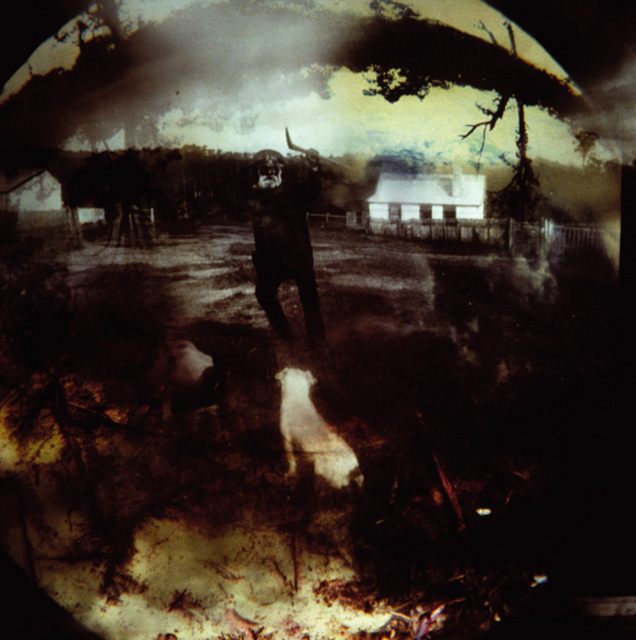


Leah King-Smith is known principally for her 1991 series Patterns of connection. This work had its origins in a project for the State Library of Victoria for which the artist was invited to select images for publication from the library's collection of nineteenth-century photographs of Aboriginal people. Most of these photographs were taken between 1860 and 1910 by professional European photographers for ethnographic or commercial purposes. 'I was seeing the old photographs as both sacred family documents on one hand, and testaments of the early brutal days of white settlement on the other, the artist has written. 'I was thus wrestling with anger, resentment, powerlessness and guilt while at the same time encountering a sense of deep connectedness, of belonging and power in working with images of my fellow Indigenous human beings.'1
In this series, King-Smith has superimposed archival images over her own photographs of the Victorian landscape. Parts of the image have been painted over, then the whole rephotographed and printed in large-scale Cibachrome. Contra to the reductions of anthropological classification, the artist remystifies the land by literally haunting it. Yet while the images seek to animate the equation of land and self that is so central to Aboriginal culture, they do not so much present 'patterns of connection' as of alienation. The figures that ghost the landscape—Aboriginal people dressed in rags and mission whites—fade at the edges, are just out of reach. The closed space between the figures and the landscape, between the received image and its resuscitation, contains a past that is ungraspable, an abruption of memory. The unpeopled landscape may host a natural religion, but in King-Smith's scheme it is one without practitioners: the darkness from which the images emerge is the darkness carried by one born without a mother tongue.
The intention in recontextualising historical photographs is a form of resuscitation, or rescue. However, these works have been criticised for romanticising Indigenous suffering—for decorously remythologising historical Aboriginal identity. For the artist and curator Brenda L Croft, the subjects are not diminished by their contrived surroundings, despite the pathos and shame of the original anthropological photographs. To the contrary, the subject's gaze triumphs over the indignity of the artifice, cutting through time to our contemporary sensibility. As the Native American artist Jimmy Durham has written of the Chiricahua Apache leader Geronimo: 'He seems to be trying to see us. He is demanding to be seen, on his own terms'.2 In this frame, the overlaid wistfulness of King-Smith's reclamations further disempower the original subjects, whose identities are lost once again in a generic Aboriginality. Indeed, the artist's project balances on a terrible double-edged sword: the fact of even looking at these stolen likenesses is a contravention of the Aboriginal cultural tradition of the averted gaze.
In another reading, the artist's treatment restores the subjects' humanity, allowing us to view them not as victims of colonisation (and the picture frame) but as human beings with their own destinies. Certainly, there is a couched violence in several of the images, most particularly Untitled #3 (1991). The figure in Untitled #5 (1991) dubbed 'King Billy' has the tragic composure of the derelict King Lear, and in the artist’s reworking seems to emerge from a scene from Wuthering heights. The use of a fish-eye lens encloses the image, as though it were isolated in its own world. In this sense, King-Smith has created a dramatic world that is entirely imaginary, which draws as much on universal narrational myths as the particular history of Indigenous peoples. Ultimately, however, these works irrevocably change the way the original photographs are understood, and in this sense it is probably important to view the originals alongside the artist's renditions.
- Hannah Fink